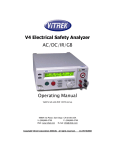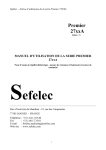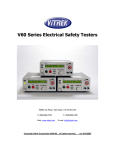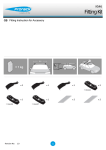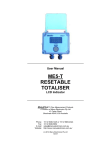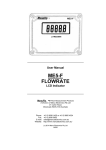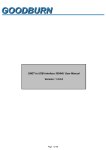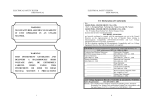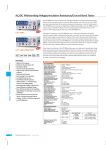Download Sentinel Manual
Transcript
ELECTRICAL SAFETY TESTER USER MANUAL ELECTRICAL SAFETY TESTER USER MANUAL EC Declaration of Conformity We GOOD WILL INSTRUMENT CO., LTD. WARNING No. 7-1, Jhongsing Rd., Tucheng City, Taipei County 236, Taiwan. MANUFACTURER ASSUMES NO LIABILITY IF UNIT OPERATED IN AN UNSAFE MANNER GOOD WILL INSTRUMENT (SUZHOU) CO., LTD. No. 69 Lushan Road, Suzhou New District Jiangsu, China. declares that the below mentioned products GPT-705A/715A, GPI-725A/735A/745A are herewith confirmed to comply with the requirements set out in the Council Directive on the Approximation of the Law of Member States relating to Electromagnetic Compatibility (89/336/EEC,92/31/EEC) and Low Voltage Equipment Directive (73/23/EEC, 93/68/EEC). For the evaluation regarding the Electromagnetic Compatibility and Low Voltage Equipment Directive, the following standards were applied: EN 61326-1: Electrical equipment for measurement, control and laboratory use –– WARNING THIS INSTRUMENT DELIVERS A GENERATES HAZARDOUSLY AND HIGH VOLTAGE (5kV). BE EXTREMELY CAREFUL WHEN USING THIS INSTRUMENT. BE SURE TO READ MANUAL SECTION PRECAUTIONS BEFORE OPERATING. 3 EMC requirements (1997+A1: 1998+A2:2001) Conducted and Radiated Emissions Electrostatic Discharge EN 55011 Group I class A: 1998 EN 61000-4-2: 1995+A1 :1998 Current Harmonic Radiated Immunity EN 61000-3-2: 2000 EN 61000-4-3: 1996+A1 :1998 Voltage Fluctuation Electrical Fast Transients EN 61000-3-3: 1995 EN 61000-4-4: 1995 Surge Immunity EN 61000-4-5: 1995 Conducted Susceptibility EN 61000-4-6: 1996 Voltage Dips/ Interrupts EN 61000-4-11: 1994 Low Voltage Equipment Directive 73/23/EEC & amended by 93/68/EEC Safety Requirements IEC/EN 61010-1: 2001 Remark: Also complied with Continuity of Protective Bonding Tester, Insulation Resistance Test, Voltage Test, and Residual Voltage Test in accordance with the Sub-Clauses 19.2, 19.3, 19.4 and 19.5 of EN 60204-1: 1997 i ii ELECTRICAL SAFETY TESTER USER MANUAL ELECTRICAL SAFETY TESTER USER MANUAL CONTENTS PAGE 1. PRODUCT INTRODUCTION............................................ 1 1-1.Description…………………………..…………………. 1 1-2.Feature……………………………..…………………… 2 2. SPECIFICATION………………………………………….. 4 3. PRECAUTIONS BEFORE OPERATION……...………... 3-1.Unpacking the instrument……..…………….………... 3-2.Safety notice………………..…………………..………. 3-3.Environment……………………………………..…….. 9 9 9 11 4. PANEL INTRODUCTION……………………..…………. 12 4-1.Front Panel……………………………………………... 12 4-2.Rear Panel……………………………………….……... 13 5. OPERATION METHOD……..…………………………… 5-1.Main display LCD..……………………………………. 5-2.Prepare the EST for Use….…………………………… 5-3.Structure of storage steps…..…………………………. 5-4.Menu parameter setup………………………………… 16 16 19 29 31 6. MAINTENANCE………..…………………………………. 40 6-1.Fuse rating and type.…………………………………... 40 6-2.Cleaning………………..……………………………….. 40 SAFETY TERMS AND SYMBOLS These terms may appear in this manual or on the product: WARNING. Warning statements identify condition or practices that could result in injury or loss of life. CAUTION. Caution statements identify conditions or practices that could result in damage to this product or other property. The equipment shall not be used for measurements within category II, III and IV. The following symbols may appear in this manual or on the product: DANGER ATTENTION Protective High Voltage refer to Manual Conductor Terminal iii iv Earth (ground) Frame or Terminal Chassis Terminal ELECTRICAL SAFETY TESTER USER MANUAL FOR UNITED KINGDOM ONLY NOTE: This lead/appliance must only be wired by competent persons. WARNING: THIS APPLIANCE MUST BE EARTHED IMPORTANT: The wires in this lead are coloured in accordance with the following code: Green/ Yellow: Blue: Brown: Earth Neutral Live (Phase) As the colours of the wires in main leads may not correspond with the colours marking identified in your plug/appliance, proceed as follows: ELECTRICAL SAFETY TESTER USER MANUAL The wire which is coloured Brown must be connected to the terminal marked with the letter L or P or coloured Brown or Red. If in doubt, consult the instructions provided with the equipment or contact the supplier. This cable/appliance should be protected by a suitably rated and approved HBC mains fuse: refer to the rating information on the equipment and/or user instructions for details. As a guide, cable of 0.75mm2 should be protected by a 3A or 5A fuse. Larger conductors would normally require 13A types, depending on the connection method used. Any moulded mains connector that requires removal /replacement must be destroyed by removal of any fuse & fuse carrier and disposed of immediately, as a plug with bared wires is hazardous if a engaged in live socket. Any re-wiring must be carried out in accordance with the information detailed on this label. The wire which is coloured Green & Yellow must be connected to the Earth terminal marked with the letter E or by the earth symbol or coloured Green or Green & Yellow. The wire which is coloured Blue must be connected to the terminal which is marked with the letter N or coloured Blue or Black. v vi ELECTRICAL SAFETY TESTER USER MANUAL ELECTRICAL SAFETY TESTER USER MANUAL 1. PRODUCT INTRODUCTION 1-2. Features The GPT/GPI-700A series offer several other features: 1) No load setup of trip current and output voltage A safe way to setup trip current and output voltage without high voltage activated. 2) A large 24×2 character LCD with adjustable LED backlight Provide a clear display about test parameters, which including group, step, mode, status, output voltage, trip current and test time. 3) Easily and quickly setup by front panel A user-friendly interface provides user an easy and quick way to set all parameters. 4) Electronic ramping and testing Digital controlled ramping time and testing time. 5) Line and load regulation Linear amplifier and feedback-control maintain output voltage disregard of the variation of load. 6) Selectable output frequency 50/60 Hz is selectable by utility setup. 7) Adjustable ARC detect level ARC detect level could be setup by utility setup. 8) 10 groups of storage and each group has 16 steps Total 10 storage groups provided for testing of different products, and each group has 16 steps. 9) Adjustable output voltage during test A special test mode in step 0, user could adjust the output voltage during testing 1-1. Description The GPT/GPI-700A series Electrical Safety Testers (EST) are designed for AD/DC Withstanding Voltage test, Insulation Resistance test (IR) and Ground Bond test (GB) in order to provide a safe and accurate test environment for the operator. With thoughtful design described in 1-2. Feature insures a safe operation of high voltage test and protect user from hazardous impact. Besides, the series can be used together with scanner box of SHB-001-1 & SHB-001-2. The Electrical Safety Testers comply with the requirement of the electrical equipment & appliance control ordinances and JIS, CSA, UL, BS and other overseas standards as well. The testers can be used for withstanding voltage test of the various types of electrical and equipment and components. The GPT/GPI-700A series are based on the family of GW withstanding voltage tester including AC Withstanding Voltage test, DC Withstanding Voltage test, Insulation Resistance test and Ground Bond test (GB). Function Model GPI-745A GPI-735A GPI-725A GPT-715A GPT-705A AC DC IR GB ˇ ˇ ˇ ˇ ˇ ˇ ˇ ˇ ˇ ˇ ˇ ˇ 1 2 ELECTRICAL SAFETY TESTER USER MANUAL 10) Flashing high voltage indicator A flashing red LED indicates dangerous situation during high voltage output is activated. 11) Data lock function Front panel could be locked or unlocked by utility setup. 12) PLC remote control The 9-pin interface provides inputs (START, RESET) and outputs (TEST, PASS, FAIL). 13) Compact size with multi-capability The compact size is geared with the Safety Test capabilities including AC Withstanding test, DC Withstanding test, Insulation Resistance test and Ground Bond test. 14) R/P Output The output terminal located on the rear panel. 15) Scanner Interface 16) RS-232 and GPIB Interface The RS-232 and GPIB interface enables remote control operation and signal processing via a PC. 3 ELECTRICAL SAFETY TESTER USER MANUAL 2. SPECIFICATION (15℃~35℃ RH≦75%) 1) AC Hi-Pot Specifications Voltage Range 0.100~5.000kV Voltage Step 5V/step Voltage Regulation 1% + 5V (line & load) Voltage Accuracy ±1% of reading ±10V (above 500V) Current Sourcing* 30~40mA(above 500V, maximu test time: 180 sec) 0.10~29.99mA(above 500V, continuous test) 0.10~10mA(below 500V, continuous test) Current Limit 0.10~40mA, 0.02mA/step Current Accuracy ±1% of reading ± 80μA 2) DC Hi-Pot Specifications (for GPT-715A/GPI-735A/745A only) Voltage Range 0.100~6.000kV Voltage Step 5V/step Voltage Regulation 1% + 5V (line & load) Voltage Accuracy ±1% of reading ±10V(above 500V) Current Sourcing* 0.10~10.00mA(above 500V, continuous test) 0.10~2mA(below 500V, continuous test) Current Limit 0.10~10mA, 0.01mA/step Current Accuracy ±1% of reading ± 50μA 4 ELECTRICAL SAFETY TESTER USER MANUAL 3) Insulation Resistance Specifications (for GPI-725A/ 735A/ 745A only) 50V/100V/500V/1000V DC Voltage 50V/100V: 1~50MΩ: ±5% of reading ±1 count 51~200MΩ: ±10% of reading ±1 count 201~2000MΩ: ±20% of reading±1 count Resistance Accuracy 500V/1000V: 1~500MΩ: ±5% of reading ±1 count 501~2000MΩ: ±10% of reading±1 count 2001~9500MΩ: ±20% of reading±1 count 4) Ground Bond Specifications (for GPI-745A only) Test Voltage Max. 8V(DC) Current Range 3~42A Current Resolution 0.02A Current Accuracy ±1% of reading ±0.2A (3~8A) ±1% of reading ±50mA (9~42A) Resistance Range 0~600mΩ Resistance Resolution 0.1mΩ Resistance Accuracy ±1% of reading ±3mΩ Test Method Four Terminals Test Mode 5) Continuity Check Specifications (for GPT-705A/715A/ GPI-725A/ 735A only) Output Current Range 0.1A(DC) Compliance Voltage Range 10% Current Resolution 0.1Ω,1Ω 5 ELECTRICAL SAFETY TESTER USER MANUAL 6) Ramp Time and Test Time AC Hi-Pot Ramp/Test time 000.0~999.9s Ramp/000.5~999.9 test DC Hi-Pot Ramp/Test time 000.0~999.9s Ramp/000.5~999.9 test Insulation Resistance Test 001.0~999.9s time Ground Bond Test Time 000.5~999.9s Continuity Check Test Time 000.5~999.9s 7) ARC Detect Detect Current 40 level (1~40mA) 8) Storage Groups Steps 9) Interface RS-232 GPIB 10) PLC Control D-sub 9 pins female 11) Scanner Interface D-sub 9 pins female 12) Real Plate Output Hi-pot terminals and GB terminals 10 16 Standard Option Standard Standard Standard interface for GPI-745A only, option for the other models 6 ELECTRICAL SAFETY TESTER USER MANUAL ELECTRICAL SAFETY TESTER USER MANUAL 13) General Power Source Operation Environment Storage temperature & Humidity Accessories Dimension Weigh AC100V, 120V, 220V, 230V±10% 50/60Hz Indoor use, altitude up to 2000m. Ambient Temperature 0℃ to 40℃. mA Relative Humidity 80% (Maximum). Installation category II Pollution Degree 2 -10℃ to 70℃. 70% (Maximum). GHT-105A × 1, GTL-115 × 1(only for GPI-745A), Instruction manual × 1, Interface Manual × 1 446(L) × 330(W) × 149(H) (m/m) Approx. 14.9 kgs * The main purpose provided by the series of instruments is for Puncture Testing. The specification is not for continuous test. The temperature of heat-sink is monitored. The test procedure will stop if the heat-sink is too hot. Please refer to Figure 2-1. * Stop the instrument for 10 minutes when continuously proceeding 30~40mA withstanding test for one hour. 40 AC Hi-Pot Spec 180sec 35 30 25 AC Hi-Pot Spec Continuous 20 15 10 8 6 4 DC Hi-Pot Spec Continuous 2 0 100 200 300 400 500 1000 2000 Figure 2-1 7 8 3000 4000 5000 6000 V ELECTRICAL SAFETY TESTER USER MANUAL 3. PRECAUTIONS BEFORE OPERATION 3-1. Unpacking the instrument The product has been fully inspected and tested before shipping from the factory. Upon receiving the instrument, please unpack and inspect it to check if there is any damage caused during transportation. If any sign of damage is found, notify the bearer and/or the dealer immediately. 3-2. Safety Notice Working place The working place must be isolated and when the high voltage is proceeding, it should be alerted with a warning sign of dangerous for special caution. Checking the Line Voltage The instruments can be applied with any kind of line voltage shown in the table below. Before connecting the power plug to an AC line outlet, make sure the voltage selector of the rear panel is set to the correct position corresponding to the line voltage. It might be damaged the instrument if connected to the wrong AC line voltage. WARNING. To avoid electrical shock the power cord protective grounding conductor must be connected to ground. The equipment shall not be used for measurements within category II, III and IV. 9 ELECTRICAL SAFETY TESTER USER MANUAL When line voltages are changed, replace the required fuses shown as below: Line voltage Range Fuse Line voltage Range Fuse 100V 90-110V T 7.0A 220V 198-242V T 4A 120V 108-132V 250V 230V 207-250V 250V WARNING. To avoid personal injury, disconnect the power cord before removing the fuse holder. Operator’s Precaution (1) With immense high output voltage and current of the puncture tester, only qualified person can operate the tester in order to avoid fatal electric shock. (2) On-job training is required for operator to better use the tester smoothly and safely. (3) The operator is prohibited to dress with metal ornaments or wear metal decoration in order to avoid electric shock. (4) The person with cardiac or wear a pacemaker must not to operate the tester. WARNING: This is a Class A product. In a domestic environment this product may cause radio interference in which case the user may be required to take adequate measures. 10 ELECTRICAL SAFETY TESTER USER MANUAL Secure Testing Never operate the tester in the place with electric circuit device around. The earth lead should be well connected in accordance with instruction. The Return Lead has to be connected to the tested object first before linking up test probe. Connect the test probe to the high voltage output terminal ONLY when conducting tests. Otherwise, keep the probe disconnected from the tester. Also, do not touch the electric conductor of test probe and the operator has to fully control the power on/off by using switch or remote control, which should not be lay aside carelessly. ELECTRICAL SAFETY TESTER USER MANUAL 4. PANEL INTRODUCTION 4-1. Front Panel WARNING: During the testing, do not touch the tested object or any other connected objects. 3-3.Environment The normal ambient temperature range of this instrument is from 0° to 40°C (32° to 104°F). To operate the instrument over this specific temperature range may cause damage to the circuits. Do not use the instrument in a place where strong magnetic or electric field exists as it may disturb the measurement. 11 12 ELECTRICAL SAFETY TESTER USER MANUAL 4-2. Rear Panel ELECTRICAL SAFETY TESTER USER MANUAL 1 2 3 5 6 7 Model Number FAIL Indicator LED PASS Indicator LED CAUTION Indicator LED Main Display LCD START Button RESET Button 8 MENU Key 9 EDIT/SAVE Key 4 10 UTILITY Key 11 FIELD Key 12 Left Arrow Key 13 Right Arrow Key 14 Knob Model number and description The red LED indicates failure of test procedure The green LED indicates pass of test procedure During test the red LED will flash to indicate dangerous. The LCD displays all message about test procedure. Press the green button to start a test procedure. Press the red button to reset/stop a test procedure. When you press the MENU key, the status becomes MENU and you can browse all groups. When you press the EDIT/SAVE key, the status EDIT is active and you can edit this step or setup. Press the EDIT/SAVE key again will save this step or setup. When you press the UTILITY key, the status UTILITY is active and you can view all the utility setups. When you edit the test step, press the FIELD key to change the active parameter of stop. Press the arrow key to adjust knob’s resolution. Press the arrow key to adjust knob’s resolution. If status EDIT is active, turn the knob to increase or decrease the value of active parameter. If status MENU is active, turn the knob to increase or decrease active Step. Turn the VR to adjust the LED backlight of LCD. 15 LCD Backlight Adjustment 16 Buzzer Volume Turn the VR to adjust the buzzer volume. Adjustment 17 High Voltage Output High voltage output terminal. Seat 18 SOURCE-Terminal High current terminal for Ground Bond test. (only for Ground Bond Test) 13 14 ELECTRICAL SAFETY TESTER USER MANUAL ELECTRICAL SAFETY TESTER USER MANUAL 5. OPERATION METHOD 19 SOURCE+ Terminal (only for Ground Bond Test) 20 Power Switch 21 SENSE+ Terminal 22 SENSE- & Return Terminal 5-1. Main Display LCD High current terminal for Ground Bond test. Storage Press the power switch to turn on the tester. Voltage Terminal for Ground Bond test. SENSE- Terminal is a voltage terminal for Ground Bond test, and Return Terminal is for all test. 23 Ground Terminal Connect Ground terminal to the earth ground. 24 Fuse Holder with To change AC source voltage, pull the fuse holder Voltage Selector and rotate it to the proper value. 25 AC Inlet Connect the AC power line to the inlet. 26 Remote Interface The remote interface performs all the functions of PLC control. 27 RS232 Terminal D-SUB 9 pin connector, Input/Output connector for RS232. 28 GPIB Terminal Blue 24 connector, Input/Output connector for IEE-488. 29 Scanner Interface D-sub 9 pins female connector for scanner box. 30 High Voltage Output High voltage output terminal. on rear panel 31 Sense + Terminal on Voltage terminal for Ground Bond test. rear panel 32 Source + Terminal High current terminal for Ground Bond test. on rear panel 33 Source - Terminal High current terminal for Ground Bond test. on rear panel 34 Sense - Terminal & Sense - terminal is a voltage terminal for Ground Return Terminal on Bond test, Return terminal is for all tests. rear panel *The instrument can be used together with scanner box of SHB-001-1 & SHB-001-2. *The Instrument can control one scanner box only. 15 Mode 1~ 0 1 ACW Output Voltage/Current V = 5 . 0 0 0 k V I ma x = 0 1 . 0 0 m A ARC Status * R E A D Y T E S T : 0 0 0 . 0 s Measurement Limit Ramp/Test Time Table of parameters Storage Group/ Step: There are total 10 groups, and each group has 16 steps. The first number represents group while the second number represents step. Ex. 3:1 3 is for group number, 1 is for step number. The test mode of tester includes: ACW: AC Withstanding voltage test. Mode DCW: DC Withstanding voltage test (only for GPT-715A/ GPI-735A/745A). I R : Insulation Resistance test (only for GPI-725A/GPI-735A /745A). G B : Ground Bond test (only for GPI-745A). C N T : Continuity Check test (only for GPT-705A/715A/ GPI-725A/735A) The total types of mode will change for different model. 16 ELECTRICAL SAFETY TESTER USER MANUAL ELECTRICAL SAFETY TESTER USER MANUAL Output voltage or current for each step A C : Output voltage (0.100~ 5.000 kV) D C : Output voltage (0.100~ 6.000 kV) Output Voltage/Current I R : Output voltage (50V/100V/500V/1000V) CHANNEL Hi: 00 Lo: 00 G B : Output current (3.00~42.00A) C N T : Output current (10mA) Status ARC Measurement Limit Ramp/Test Time The status of tester includes: M E N U : Browse and check steps of test. E D I T : Edit parameters S A V E : Save parameters U T I L : Browse and check system utility. R E A D Y: Ready for test T E S T : Testing P A S S : The result of test is pass F A I L : The result of test is fail S T O P : Stop the test If the ARC function is enable, the sign “*” means that there is ARC during test. Lower and upper limit of measurement I m a x / I m i n : Current measurement limit (ACW & DCW) R m a x / R m i n : Resistance measurement limit(IR&GB&CNT) Ramp time and test time voltage A C : Ramp (000.0~999.9s) Test (000.5~999.9s) D C : Ramp (000.0~999.9s) time Test (000.5~999.9s) ramp test I R : Test (001.0~999.9s) G B : Test (000.5~999.9s) C N T : Test (000.5~999.9s) 17 Set the Scanner Box to output and return function through the setting of CH1 and CH2. If the setting is Hi=01 and Lo=02, that means the high voltage is output from CH1 and return from CH2. If Hi and Lo are set to 00, that means no signal is sent to Scanner Box. * When the measured load becomes capacitive, the test time must be extended. * Ramp Time Ramp Time setting provides a fast and safe way to detect short circuit or faulty wiring of your Device Under Test. GPT-700A monitors the voltage level during the first stage of Ramp Time to find out short condition. If the voltage still remains less than 80V after 0.1s, GPT-700A cuts off the output and displays the message “Short”. Therefore the short current will be shut off before it grows beyond Imax, the current limit setting. When checking GPT-700A current accuracy, if the DUT has less than 2Mohm input impedance, turn off the Ramp Time setting. GPT-700A may shut down the voltage taking the low impedance as a sign of short circuit. time 18 ELECTRICAL SAFETY TESTER USER MANUAL ELECTRICAL SAFETY TESTER USER MANUAL 5-2. Prepare the EST for Use z z To view the Storage Steps 1. Press the MENU key to enter status MENU. To Edit/Save the Storage Steps 1. Follow the above procedure “To View the Storage Steps “ to select a step. 2. Press the EDIT/SAVE key to enter status EDIT. MENU EDIT MENU EDIT/SAVE 2. Use the left and right arrow keys to change knob’s resolution (group or step). Use the knob to change the active step. 3. Use knob to adjust parameter. Use arrow keys to change knob’s resolution. 0-00 AC 19 A CW 20 ELECTRICAL SAFETY TESTER USER MANUAL ELECTRICAL SAFETY TESTER USER MANUAL 4. Use FIELD key to change active parameter. z To Begin a Group Test 1. Repeat the procedure “To View the Storage Steps” to select a step. 2. Press RESET button to enter status READY. V=2 . 00 0 k V READY FIELD RESET 5. Repeat step 3 and 4 to adjust parameter. 6. After setting all parameters, press EDIT/SAVE key to save the step. The status will become SAVE. After the step is saved, the status will return to EDIT. SAVE 3. Make sure the test environment is safe. 4. Press START button to start the test while the status TEST is active and the CAUTION LED flashes. TEST EDIT/SAVE 7. Repeat the procedure “To View the Storage Steps” to select another step. 21 START 22 ELECTRICAL SAFETY TESTER USER MANUAL ELECTRICAL SAFETY TESTER USER MANUAL 5. If you press RESET button the test will stop immediately. 7. If the result fails, the FAIL LED will be activated and the buzzer will alarm operator. To stop the alarm, press RESET button again. FAIL STOP RESET RESET 6. If the result is pass, the PASS LED will be active. 8. Use knob to view the result of group step by step. PASS 23 1-00 24 ELECTRICAL SAFETY TESTER USER MANUAL ELECTRICAL SAFETY TESTER USER MANUAL z 3. Table of system utility: Parameter Option To View the System Utility 1. Press the UTILITY key to enter status UTIL. From STEP 1 GROUP TEST UTIL ARC MODE UTILITY From the present step DISABLE ENABLE & STOP ENABLE & CONTINUE ARC CURRENT 2. Use the knob or arrow keys to change the active parameter. GRO UP FRO M AC FREQUENCY T E ST STEP 1 50 Hz 60 Hz MODE 1 TEST CONTROL MODE MODE 2 MODE 3 MODE 4 UNLOCKED DATA LOCK CONTI. CALIBRATION 25 LOCKED Description The group test procedure always begins from step 1 to end of group. e.g. 01~01 The group test procedure always begins from the step selected to end of group. e.g. 01~03 Disable the function arc detection. Enable the arc detection and stop the test when arc is active. Enable the arc detection and continue the test when arc is active. Set the current level of arc detection. Set the AC hi-pot output frequency to 50 Hz. Set the AC hi-pot output frequency to 60 Hz. Control mode of front panel. Mode 1: Reset first (press reset button before test) Mode 2: Press start button directly. Mode 3: REMOTE I/O enable (the start button is disable) Mode 4: Reserved. Accept and save all parameters of test step and utility. Refuse to change any parameters of test step and utility. Calibrate the short resistance of test leads for test of Continuity check. 26 ELECTRICAL SAFETY TESTER USER MANUAL ELECTRICAL SAFETY TESTER USER MANUAL Stop on fail Stop on fail at the DUT detection. Stop on pass Stop on pass at the DUT detection. IR TEST MODE Timer Reach the time of determination for ZERO CHECK (GB only) Interface FAIL Setting 3. Use knob to adjust parameter. Use arrow keys to change knob’s resolution. pass or fail. Zero check by shorting the resistance of test leads only for ground bond test. T E S T F R O M RS-232 Baud 1200, 2400, 4800, 9600. Rate GPIB 00~31 Address Stop The operation will stop upon the failure Continue MO DE STE P occurred at any step of group test. The operation will not stop until all 16 group steps has been tested. z To Edit/Save the System Utility 1. Follow the above procedure “To View the System Utility” to select a parameter. 2. Press the EDIT/SAVE key to enter status EDIT. 4. After setting this parameter, press EDIT/SAVE key to save the parameter. The status will become SAVE. After the parameter is saved, the status will return to EDIT. SAVE EDIT EDIT/SAVE EDIT/SAVE 5. Repeat the procedure “To View the System Utility” to select another parameter. 27 28 ELECTRICAL SAFETY TESTER USER MANUAL ELECTRICAL SAFETY TESTER USER MANUAL 5-3. Structure of storage steps After each step has been tested, the tested status will be shown on the screen: The storage steps of EST are total 10 groups (group 0 ~ group 9), 16 steps (step 1 ~ step 16) for each group. Except these steps, there is another step “COM” for special test. The presentation of storage steps is Group: Step. The first number represents group while the second represents step. Group 0 Step 1 0:1 ↓ Group 1 1:1 ↓ Group 2 2:1 ↓ Group 3 3:1 ↓ Group 4 4:1 ↓ Group Group ~ 5 9 5:1 9:1 ↓ ↓ Step 2 0:2 ↓ 1:2 ↓ 2:2 ↓ 3:2 ↓ 4:2 ↓ 5:2 ↓ 9:2 ↓ Step 3 0:3 ↓ 1:3 ↓ 2:3 ↓ 3:3 ↓ 4:3 ↓ 5:3 ↓ 9:3 ↓ Step 4 0:4 ↓ 1:4 ↓ 2:4 ↓ 3:4 ↓ 4:4 ↓ 5:4 ↓ 9:4 ↓ Step 5 0:5 ∣ Step 16 0:16 1:5 2:5 3:5 4:5 5:5 9:5 1:16 2:16 3:16 4:16 5:16 9:16 The special test step “COM” contains another two types of test: CAC and CDC. The function of CAC (CDC) is as same as ACW (DCW), except user could adjust the output voltage during test. 29 Step 1 2 3 4 5 6 7 8 9 0 1 2 3 4 5 6 Test P P P P P P P P P P P P P P P P N: P: F: Step 1: Step 2: Step 3: Step 4: Step 5: Step 6: Step 7: Step 8: Step 9: Step 0: Step 1: Step 2: Step 3: Step 4: Step 5: Step 6: Empty Pass Fail CH1 CH2 CH3 CH4 CH5 CH6 CH7 CH8 CH9 CH10 CH11 CH12 CH13 CH15 CH15 CH16 30 ELECTRICAL SAFETY TESTER USER MANUAL 5-4. Menu parameter setup z AC/DC withstanding voltage test (ACW, DCW— only for GPT-715A /GPI-735A/745A) Press MENU key to enter status MENU then use knob and arrow keys to select a step. Press EDIT/SAVE key to enter status EDIT. Now the cursor stays at the “test mode” field. Use the knob to select mode ACW (DCW). Functionality of FIELD key: Test mode ACW(DCW) Output voltage V=X.XXXkV Measurement upper limit Imax=XX.XXmA Measurement lower limit Imin=XX.XXmA Ramping time RAMP=XXX.Xs Testing time TEST=XXX.Xs ELECTRICAL SAFETY TESTER USER MANUAL Press FIELD key to edit next field “output voltage”. Use the knob to adjust the desired output voltage while use the arrow keys to adjust the knob’s resolution (0.100~5.000kV for ACW, 0.100~ 6.000kV for DCW). Press FIELD key again to enter next field “measurement upper limit”. Use the knob to adjust the desired upper limit of leakage current while use the arrow keys to adjust the knob’s resolution (0.10~40mA for ACW, 0.10~10mA for DCW). Press FIELD key again to enter next field “measurement lower limit”. Use the knob to adjust the desired lower limit of leakage current while use the arrow keys to adjust the knob’s resolution (0.10~40mA for ACW, 0.10~10mA for DCW). Press FIELD key again to enter next field “ramping time”. Use the knob to adjust the desired ramping time while use the arrow keys to adjust the knob’s resolution (0~999.9s). Press FIELD key again to enter next field “testing time”. Use the knob to adjust the desired testing time while use the arrow keys to adjust the knob’s resolution (0.5~999.9s). Press FIELD key again to return the first field “test mode” again. Press EDIT/SAVE key to save all the parameters. AC/DC withstanding voltage Test Result Message I= “UUUUU” means the DUT current is over the metering range of ACW/DCW. The output could be short or over 40mA(ACW) or 10mA(DCW). Channel Hi=00 Lo=00 31 32 ELECTRICAL SAFETY TESTER USER MANUAL z Continuous AC/DC withstanding voltage test (CAC,CDC-only for GPT-715A/GPI-735A/745A) The CAC/CDC test is available only on step “0:0”. Like the traditional hi-pot tester, you can use the knob and arrow keys to adjust output voltage during test. All the parameters of CAC/CDC are the same as ACW/DCW, except the testing time. The testing of CAC/CDC is not limited. z Insulation Resistance test (IR- only for GPI-725A/735A/745A) Press MENU key to enter status MENU then use knob and arrow keys to select a step. Press EDIT/SAVE key to enter status EDIT. Now the cursor stays at the “test mode” field. Use the knob to select mode IR. Functionality of FIELD key: Test mode IR ELECTRICAL SAFETY TESTER USER MANUAL Press FIELD key to edit next field “output voltage”. Use the knob to adjust the desired output voltage (50V/100V/500V/1000V). Press FIELD key again to enter next field “measurement upper limit”. Use the knob to adjust the desired upper limit of resistance while use the arrow keys to adjust the knob’s resolution(0~9999MΩ, 0~2000MΩ 50V/100V). Press FIELD key again to enter next field “measurement lower limit”. Use the knob to adjust the desired lower limit of resistance while use the arrow keys to adjust the knob’s resolution(0~9999MΩ, 0~2000MΩ 50V/100V). Press FIELD key again to enter next field “testing time”. Use the knob to adjust the desired testing time while use the arrow keys to adjust the knob’s resolution (1.0~999.9s). Press FIELD key again to return the first field “test mode” again. Press EDIT/SAVE key to save all the parameters. Output voltage V=X.XXXkV Measurement upper limit Rmax=XXXXMΩ Measurement lower limit Rmin=XXXXMΩ Testing time TEST=XXX.Xs Channel Hi=00 Lo=00 33 34 ELECTRICAL SAFETY TESTER USER MANUAL z Ground Bonding Test (GB- only for GPI-745A) Press MENU key to enter status MENU then use knob and arrow keys to select a step. Press EDIT/SAVE key to enter status EDIT. Now the cursor stays at the “test mode” field. Use the knob to select mode GB. Functionality of FIELD key: Test mode GB Output voltage I=XX.XXA Measurement upper limit Rmax= XXX.XmΩ Measurement lower limit Rmin=XXX.XmΩ ELECTRICAL SAFETY TESTER USER MANUAL Press FIELD key to edit next field “output current”. Use the knob to adjust the desired output current (3.00~42.00A). Press FIELD key again to enter next field “measurement upper limit”. Use the knob to adjust the desired upper limit of resistance while use the arrow keys to adjust the knob’s resolution (0~620.0mΩ). Press FIELD key again to enter next field “measurement lower limit”. Use the knob to adjust the desired lower limit of resistance while use the arrow keys to adjust the knob’s resolution (0~620.0mΩ). Press FIELD key again to enter next field “testing time”. Use the knob to adjust the desired testing time while use the arrow keys to adjust the knob’s resolution (0.5~999.9s). Press FIELD key again to return the first field “test mode” again. Press EDIT/SAVE key to save all the parameters. When the Scanner Box is disconnected, the channel selected menu would not exist. When set channel to Hi:00 and Lo:10, the test signal is sent to the instrument only, will not be sent to scanner. Testing time TEST=XXX.Xs Channel Hi=00 Lo=00 35 36 ELECTRICAL SAFETY TESTER USER MANUAL Continuity Check (Cnt) Press MENU key to enter status MENU then use knob and arrow keys to select a step. Press EDIT/SAVE key to enter status EDIT. Now the cursor stays at the “test mode” field. Use the knob to select mode Cnt. The output current is fixed to 0.100A. Functionality of FIELD key: Test mode Cnt Measurement upper limit Rmax=XXXXΩ Testing time TEST=X.XXXs Press FIELD key to enter next field “measurement upper limit”. Use the knob to adjust the desired upper limit of resistance while use the arrow keys to adjust the knob’s resolution (0~1.200Ω). Press FIELD key again to enter next field “testing time”. Use the knob to adjust the desired testing time while use the arrow keys to adjust the knob’s resolution (0.5~999.9s). Press FIELD key again to return the first field “test mode” again. Press EDIT/SAVE key to save all the parameters. 37 ELECTRICAL SAFETY TESTER USER MANUAL Functionality of remote interface The remote interface provides two inputs (START and RESET) and three outputs (TESTING, PASS and FAIL). COMMON START RESET PASS 1 PASS 2 TESTING 1 TESTING 2 FAIL 2 FAIL 1 RESET: START: TESTING 1, TESTING 2 PASS 1, PASS 2 FAIL 1, FAIL 2 Connect “RESET”(pin 1) to “COMMON”(pin 3) will reset or interrupt this machine (as same as the functionality of RESET button at front panel). In status READY, connect “TEST”(pin 2) to “COMMON”(pin 3) will start the test procedure (as same as the functionality of START button at front panel). During test, the “TESTING 1”(pin 4) and TESTING 2”(pin 5) will be shorted. If the result of test is “pass”, the “PASS 1”(pin 6) and “PASS 2”(pin 7) will be shorted. If the result of test is “fail”, the “FAIL 1”(pin 8) and “FAIL 2”(pin 9) will be shorted. *The max. power rating of PASS/FAIL/TESTING outputs: Apply voltage: +/-300V Carry current:: +/-100mA Power dissipation: 400mW 38 ELECTRICAL SAFETY TESTER USER MANUAL ELECTRICAL SAFETY TESTER USER MANUAL 6. MAINTENANCE EST REMOTE REMOTE INTERFACE CONTROLLER RESET (pin 1) START (pin 2) COMMON (pin 3) TESTING1 (pin 4) TESTING2 (pin 5) PASS1 (pin 6) PASS2 (pin 7) The following instructions are used by qualified person only to avoid electrical shock, do not perform any service other than contained in the operation instructions unless you are qualified to do so. 6-1. Fuse Rating and type If the fuse blows, the product will not operate. Try to determine and correct the cause of the blown fuse, then replace the fuse with correct rating and type shown as below: FAIL1 (pin 8) FAIL2 (pin 9) The function key of front panel can not be used when any two pins of the Reset、Start or Common function of remote control appear short circuit. Please check the remote control device. Line voltage 100V 120V Range Fuse Line voltage Range Fuse 90-110V 108-132V T 7.0A 250V 220V 230V 198-242V 207-250V T4A 250V WARNING: For continued fire protection, replace only with 250V fuse of the specified type and rating, and disconnect the power cord before proceeding fuse replacement. 6-2. Cleaning To keep the instrument clean, wipe the case with a damp cloth and detergent. Do not use abrasives or solvents. 39 40


























